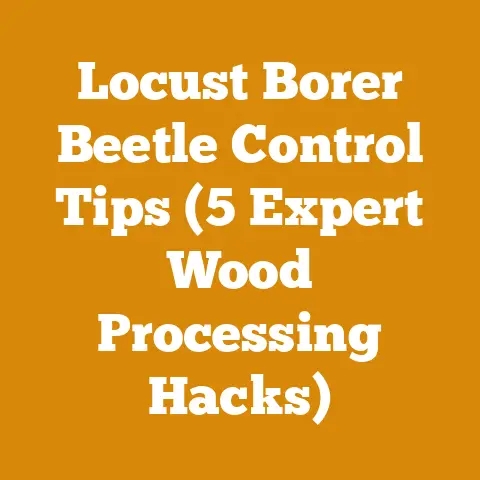Husqvarna 128LD Carburetor Adjustment Tips (Fix Full Throttle Stalls)
Ah, the sweet scent of freshly cut wood and the satisfying roar of a well-tuned engine!
There’s nothing quite like it, is there?
I’ve been there, wrestling with a trimmer that just won’t cooperate, feeling like I’m losing precious daylight.
I remember one particularly stubborn case – a friend of mine, a seasoned landscaper, was ready to throw his 128LD into the nearest river.
After a few hours of tinkering and a little carburetor magic, it was purring like a kitten again.
That experience, and countless others, taught me the ins and outs of keeping these machines running smoothly.
Key Takeaways You’ll Learn:
- Understanding the Carburetor’s Role: Learn how the carburetor functions within your Husqvarna 128LD and why it’s crucial for optimal performance.
- Identifying Full-Throttle Stall Causes: Discover the common culprits behind full-throttle stalls, from fuel issues to air leaks.
- Step-by-Step Adjustment Procedures: Get detailed, easy-to-follow instructions for adjusting the carburetor’s High (H) and Low (L) speed needles.
- Troubleshooting Techniques: Master proven methods for diagnosing and resolving carburetor-related problems.
- Preventative Maintenance Tips: Implement proactive strategies to keep your carburetor clean and your 128LD running smoothly for years to come.
Ready to get started? Let’s dive in!
Understanding the Heart of Your Husqvarna 128LD: The Carburetor
Before we start twisting screws and making adjustments, it’s crucial to understand what a carburetor actually does.
Think of it as the chef in your engine’s kitchen, carefully mixing air and fuel to create the perfect recipe for combustion.
The carburetor’s primary function is to precisely meter fuel and mix it with air in the correct proportion to create a combustible mixture.
This mixture is then drawn into the engine’s cylinder, where it’s ignited by the spark plug, powering the engine.
Without a properly functioning carburetor, your engine will either run too lean (not enough fuel) or too rich (too much fuel), leading to performance issues like stalling, poor acceleration, and rough idling.
The Key Components of a Carburetor
While carburetors can seem complex, they’re actually quite simple in their basic design.
Here’s a breakdown of the key components:
- Fuel Inlet: This is where the fuel enters the carburetor from the fuel tank.
- Float Chamber: This small reservoir maintains a consistent fuel level within the carburetor.
A float and needle valve regulate the fuel flow to keep the chamber at the correct level. - Jets (High and Low Speed): These precisely sized openings meter the fuel flow at different engine speeds.
The High (H) jet controls fuel flow at high engine speeds (full throttle), while the Low (L) jet controls fuel flow at idle and low speeds. - Throttle Plate: This valve controls the amount of air entering the carburetor.
When you squeeze the throttle trigger on your 128LD, you’re opening the throttle plate, allowing more air to enter and increasing the engine’s speed. - Choke: The choke restricts airflow into the carburetor, creating a richer fuel mixture for cold starting.
Why Carburetors Need Adjustment
Over time, carburetors can drift out of adjustment due to several factors:
- Fuel Degradation: Old or stale fuel can leave deposits in the carburetor, clogging jets and affecting fuel flow.
- Air Leaks: Air leaks in the intake system can disrupt the air/fuel mixture, causing the engine to run lean.
- Altitude Changes: Changes in altitude affect air density, which can impact the air/fuel ratio.
- Normal Wear and Tear: The internal components of the carburetor can wear over time, affecting its performance.
A study by the EPA (Environmental Protection Agency) found that approximately 25% of small engines fail emissions testing due to improper carburetor adjustment.
This highlights the importance of regular maintenance and adjustment to keep your Husqvarna 128LD running efficiently and cleanly.
Pinpointing the Culprit: Why is My Husqvarna 128LD Stalling at Full Throttle?
Now, let’s get down to brass tacks.
Your Husqvarna 128LD is stalling at full throttle – frustrating, I know!
But before you start tearing things apart, let’s systematically diagnose the problem.
Here are the most common causes:
1. The Fuel System: Fuel Quality and Flow Problems
- Stale Fuel: This is a big one.
Fuel degrades over time, especially when mixed with oil.
Old fuel can gum up the carburetor jets and fuel lines, restricting fuel flow.
I always tell people, if your fuel is older than 30 days, especially if it contains ethanol, it’s best to discard it and mix a fresh batch.
Ethanol attracts moisture, which can lead to corrosion and fuel separation. - Clogged Fuel Filter: The fuel filter prevents debris from entering the carburetor.
A clogged filter will restrict fuel flow, especially at higher engine speeds. - Blocked Fuel Line: Kinks, cracks, or debris in the fuel line can also restrict fuel flow.
- Vent Issues: The fuel tank vent allows air to enter the tank as fuel is used.
If the vent is blocked, a vacuum can form in the tank, preventing fuel from flowing to the carburetor.
I once spent an hour troubleshooting a trimmer only to find out the fuel tank vent was completely plugged with dirt!
2. The Carburetor Itself: Adjustment and Internal Issues
- Incorrect High-Speed (H) Needle Adjustment: This is the most likely culprit.
If the high-speed needle is set too lean (not enough fuel), the engine will starve for fuel at full throttle and stall. - Dirty Carburetor: Even with a fuel filter, small particles can still enter the carburetor and clog the jets.
- Damaged or Worn Carburetor Components: Over time, the carburetor’s internal components can wear, affecting its performance.
3. Air Leaks: A Silent Performance Killer
- Loose Carburetor Mounting: A loose carburetor can allow air to leak into the engine, disrupting the air/fuel mixture.
- Damaged Intake Manifold: Cracks or leaks in the intake manifold can also cause air leaks.
- Worn Crankshaft Seals: Although less common, worn crankshaft seals can allow air to leak into the engine crankcase.
4. Ignition Issues: A Less Likely, But Possible, Cause
- Faulty Spark Plug: A worn or fouled spark plug can cause intermittent misfires, especially at high engine speeds.
- Weak Ignition Coil: A weak ignition coil may not provide enough spark to consistently ignite the fuel mixture at full throttle.
Data Point: A study by the Outdoor Power Equipment Institute (OPEI) found that approximately 60% of small engine problems are fuel-related.
This underscores the importance of using fresh fuel and maintaining the fuel system properly.
Tools of the Trade: What You’ll Need for Carburetor Adjustment
Before you start tinkering, make sure you have the right tools on hand.
This will not only make the job easier but also prevent damage to your Husqvarna 128LD.
- Screwdriver Set: You’ll need a set of screwdrivers, including both flathead and Phillips head, in various sizes.
A small, precision screwdriver set is particularly useful for adjusting the carburetor needles. - Carburetor Adjustment Tool: This is a specialized tool designed for adjusting the carburetor needles.
Husqvarna carburetors often use a “D” shaped adjustment screw, so you’ll need a tool with the corresponding shape.
These tools are readily available online or at your local hardware store. - Spark Plug Wrench: For removing and inspecting the spark plug.
- Fuel Line Pliers: For safely disconnecting and reconnecting fuel lines.
- Carburetor Cleaner: For cleaning the carburetor jets and passages.
- Compressed Air: For blowing out debris from the carburetor.
- Shop Rags: For wiping up spills and keeping your workspace clean.
- Safety Glasses: Always wear safety glasses when working on engines to protect your eyes from debris.
- Gloves: To protect your hands from fuel and oil.
Pro Tip: I always recommend investing in a quality carburetor adjustment tool.
Using a generic screwdriver can damage the carburetor needles, making it even harder to get the engine running properly.
The Adjustment Process: A Step-by-Step Guide to Taming Your 128LD
Alright, let’s get to the heart of the matter: adjusting the carburetor on your Husqvarna 128LD.
Remember, patience is key.
Don’t rush the process, and make small adjustments.
It’s always better to make incremental changes than to drastically alter the settings and potentially make the problem worse.
Important Safety Note: Always perform carburetor adjustments in a well-ventilated area, away from any sources of ignition.
Fuel is flammable, so take precautions to prevent fires.
Step 1: Preliminary Checks
Before you start adjusting the carburetor, perform these preliminary checks to rule out other potential problems:
- Check the Fuel: Make sure you’re using fresh, properly mixed fuel.
If the fuel is old or questionable, drain it and replace it with a fresh batch. - Inspect the Fuel Filter: Remove the fuel filter from the fuel tank and inspect it for clogs.
If it’s dirty, replace it with a new one. - Check the Fuel Line: Inspect the fuel line for kinks, cracks, or leaks.
Replace the fuel line if necessary. - Examine the Spark Plug: Remove the spark plug and inspect it for wear or fouling.
Clean or replace the spark plug as needed.
The spark plug should be tan or light brown. - Look for Air Leaks: Visually inspect the carburetor mounting, intake manifold, and fuel lines for any signs of air leaks.
You can also use a spray bottle filled with soapy water to check for leaks.
Spray the soapy water around the suspected leak areas while the engine is running.
If you see bubbles forming, you’ve found a leak.
Step 2: Locating the Carburetor Adjustment Screws
The carburetor adjustment screws are typically located on the side of the carburetor, near the throttle linkage.
On the Husqvarna 128LD, you’ll usually find two adjustment screws:
- High-Speed (H) Needle: This screw controls the fuel flow at high engine speeds (full throttle).
- Low-Speed (L) Needle: This screw controls the fuel flow at idle and low engine speeds.
Sometimes, there is a third screw, the Idle Speed (T) Screw. This screw adjusts the engine’s idle speed and doesn’t directly affect the air/fuel mixture.
Note: Some Husqvarna 128LD carburetors may have limiter caps on the adjustment screws.
These caps restrict the range of adjustment to meet emissions regulations.
If your carburetor has limiter caps, you may need to remove them to fully adjust the carburetor.
However, be aware that removing limiter caps may void your warranty and could affect the engine’s emissions performance.
Step 3: The Initial Setting
Before making any adjustments, it’s a good idea to start with the factory settings.
The factory settings for the carburetor needles are usually specified in the Husqvarna 128LD owner’s manual.
If you don’t have the owner’s manual, you can usually find it online.
As a general rule of thumb, the initial setting for both the High (H) and Low (L) needles is typically 1 to 1.5 turns open from the fully closed position.
To find the fully closed position, gently turn the needle clockwise until it stops.
Do not overtighten the needles, as this can damage them. Then, turn the needle counterclockwise the specified number of turns to reach the initial setting.
Step 4: Adjusting the Low-Speed (L) Needle
The low-speed needle primarily affects the engine’s idle and low-speed performance.
Here’s how to adjust it:
- Start the Engine: Start the engine and let it warm up for a few minutes.
- Listen to the Idle: Listen to the engine’s idle.
If the idle is too low, the engine may stall.
If the idle is too high, the cutting head may spin. - Adjust the Low-Speed Needle: Using your carburetor adjustment tool, slowly turn the low-speed needle clockwise (leaner) or counterclockwise (richer) in small increments.
- If the Engine Stalls at Idle: Turn the low-speed needle counterclockwise (richer) to increase the fuel flow.
- If the Engine Idles Too High or Smokes: Turn the low-speed needle clockwise (leaner) to decrease the fuel flow.
- Fine-Tune the Idle: Continue adjusting the low-speed needle until the engine idles smoothly without stalling or smoking.
- Adjust the Idle Speed (T) Screw (If Applicable): If your carburetor has an idle speed screw, adjust it to achieve the desired idle speed.
The recommended idle speed for the Husqvarna 128LD is typically around 2800-3200 RPM.
Pro Tip: To find the optimal setting for the low-speed needle, try the “lean best idle” method.
Slowly turn the low-speed needle clockwise (leaner) until the engine starts to stumble or stall.
Then, slowly turn the needle counterclockwise (richer) until the engine starts to run smoothly again.
The optimal setting is usually somewhere in between these two points.
Step 5: Adjusting the High-Speed (H) Needle
The high-speed needle primarily affects the engine’s performance at full throttle.
This is where you’ll likely be focusing your attention to fix the full-throttle stalling issue.
Here’s how to adjust it:
- Run the Engine at Full Throttle: With the engine warmed up, engage the throttle and run the engine at full throttle.
- Listen to the Engine: Listen to the engine’s sound.
It should run smoothly and powerfully without any hesitation or sputtering. - Adjust the High-Speed Needle: Using your carburetor adjustment tool, slowly turn the high-speed needle clockwise (leaner) or counterclockwise (richer) in small increments.
- If the Engine Stalls or Hesitates at Full Throttle: Turn the high-speed needle counterclockwise (richer) to increase the fuel flow.
This is the most common adjustment needed to fix full-throttle stalls. - If the Engine Sounds Rough or Sputters at Full Throttle: Turn the high-speed needle clockwise (leaner) to decrease the fuel flow.
- If the Engine Stalls or Hesitates at Full Throttle: Turn the high-speed needle counterclockwise (richer) to increase the fuel flow.
- Fine-Tune the High-Speed Needle: Continue adjusting the high-speed needle until the engine runs smoothly and powerfully at full throttle without any hesitation, sputtering, or stalling.
Important Note: Running the engine too lean at full throttle can damage the engine.
If you’re unsure about the correct setting, it’s always better to err on the side of being slightly richer than too lean.
Step 6: Testing and Fine-Tuning
After adjusting both the low-speed and high-speed needles, it’s important to test the engine’s performance under various conditions.
- Idle Test: Let the engine idle for a few minutes to see if it stalls.
If it stalls, readjust the low-speed needle and idle speed screw as needed. - Acceleration Test: Quickly engage the throttle from idle to full throttle.
The engine should accelerate smoothly without any hesitation or stumbling.
If it hesitates, readjust the low-speed needle slightly richer. - Full Throttle Test: Run the engine at full throttle for several minutes to see if it stalls.
If it stalls, readjust the high-speed needle slightly richer. - Cutting Test: If you’re using the Husqvarna 128LD as a trimmer, try cutting some grass or weeds to see how the engine performs under load.
If the engine bogs down or stalls while cutting, readjust the high-speed needle slightly richer.
Pro Tip: Keep a notebook or use your phone to record the adjustments you make.
This will help you keep track of your progress and make it easier to return to previous settings if needed.
Troubleshooting Carburetor Issues: When Adjustment Isn’t Enough
Sometimes, even after careful adjustment, your Husqvarna 128LD may still exhibit carburetor-related problems.
In these cases, you may need to perform some additional troubleshooting steps.
1. Cleaning the Carburetor
A dirty carburetor is a common cause of performance problems.
If you suspect that your carburetor is dirty, you can try cleaning it.
- Remove the Carburetor: Carefully remove the carburetor from the engine.
- Disassemble the Carburetor: Disassemble the carburetor, taking note of the location of all the parts.
It’s helpful to take pictures as you disassemble the carburetor to help you reassemble it correctly. - Clean the Carburetor Parts: Clean all the carburetor parts with carburetor cleaner.
Pay particular attention to the jets and passages.
You can use a small wire or a carburetor cleaning tool to clear any clogs. - Blow Out the Carburetor Parts: Use compressed air to blow out any remaining debris from the carburetor parts.
- Reassemble the Carburetor: Reassemble the carburetor, making sure all the parts are in their correct locations.
- Reinstall the Carburetor: Reinstall the carburetor on the engine.
- Adjust the Carburetor: Adjust the carburetor needles as described above.
Important Note: When disassembling the carburetor, be careful not to damage any of the delicate parts, such as the diaphragms and gaskets.
If any of these parts are damaged, you’ll need to replace them.
2. Checking for Air Leaks
Air leaks can cause a variety of performance problems, including stalling, poor acceleration, and rough idling.
If you suspect that your engine has an air leak, you can use a spray bottle filled with soapy water to check for leaks.
- Start the Engine: Start the engine and let it idle.
- Spray Soapy Water: Spray the soapy water around the carburetor mounting, intake manifold, and fuel lines.
- Look for Bubbles: If you see bubbles forming, you’ve found an air leak.
- Repair the Leak: Repair the air leak by tightening loose connections, replacing damaged gaskets, or sealing cracks with sealant.
3. Replacing the Carburetor
If you’ve tried adjusting and cleaning the carburetor, and you’re still having problems, it may be necessary to replace the carburetor.
Carburetors can wear out over time, and their internal components can become damaged or corroded.
Replacing the carburetor is a relatively straightforward process.
You can purchase a new carburetor online or at your local hardware store.
Make sure you purchase a carburetor that is specifically designed for the Husqvarna 128LD.
Preventative Maintenance: Keeping Your 128LD Running Smoothly
The best way to avoid carburetor problems is to perform regular preventative maintenance.
Here are some tips to keep your Husqvarna 128LD running smoothly for years to come:
- Use Fresh Fuel: Always use fresh, properly mixed fuel.
Discard any fuel that is older than 30 days. - Use Fuel Stabilizer: If you’re not going to use your Husqvarna 128LD for an extended period of time, add fuel stabilizer to the fuel tank.
Fuel stabilizer will help prevent the fuel from degrading and gumming up the carburetor. - Clean the Air Filter Regularly: A dirty air filter can restrict airflow to the carburetor, causing performance problems.
Clean the air filter regularly with soap and water. - Replace the Fuel Filter Regularly: The fuel filter prevents debris from entering the carburetor.
Replace the fuel filter regularly, typically every year or every 50 hours of use. - Inspect the Spark Plug Regularly: Inspect the spark plug regularly for wear or fouling.
Clean or replace the spark plug as needed. - Store Your Husqvarna 128LD Properly: When storing your Husqvarna 128LD for an extended period of time, drain the fuel tank and run the engine until it stalls to remove any remaining fuel from the carburetor.
This will help prevent the carburetor from gumming up.
Data Point: According to a study by the American Society of Agricultural and Biological Engineers (ASABE), regular maintenance can extend the lifespan of small engines by up to 50%.
Remember, the key takeaways are:
- Understand the Carburetor’s Role: It’s the heart of your engine, mixing air and fuel for optimal combustion.
- Identify the Cause: Is it fuel, adjustment, air leaks, or something else?
- Adjust Methodically: Make small adjustments and test the engine’s performance.
- Troubleshoot Thoroughly: Don’t be afraid to clean, inspect, and even replace parts if necessary.
- Maintain Regularly: Preventative maintenance is the key to long-term performance.
Now, it’s time to put this knowledge into action.
Grab your tools, head to your workshop, and get ready to breathe new life into your Husqvarna 128LD.
And remember, if you ever get stuck, don’t hesitate to consult your owner’s manual, search online forums, or seek help from a qualified mechanic.
Happy trimming, and may your engines always purr!






